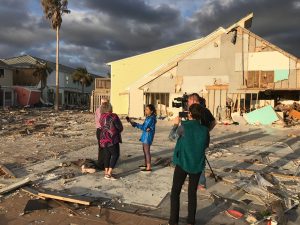I just spent a few days on the Florida panhandle, where I went to see firsthand the ground-zero of Hurricane Michael at Mexico Beach. I was there 4 months to the day after Michael made its devastating landfall. Stunned. Sick to the stomach. Scary. Despair. Nothing in my experience prepared me for the sight. Standing there on that ground amidst all that wreckage, the lingering trauma was palpable in a way that words and pictures can’t convey.
AIRE’s work is mainly as wayfinders and developers of solar for nonprofits, but moreover, as change agents for a renewable, democratic energy system altogether. For this reason, “connecting-the-dots” has become a significant theme in my posts. This one will be no exception.
I want to highlight the dissonance between what happened at Mexico Beach, why it happened, and the expressed determination to rebuild (without rethinking). It’s a form of willpower manipulation we’ve been conditioned to repeat. I guess it’s called “the American way!” It might also be called hubris. More charitably for those affected like the folks I met in Mexico Beach, their attachment to it and their histories there were wiped away by wind and water like they’d never seen, and I felt for them and their loss. In any event, between hurricane disasters and so-called resilience, there seems to be a blind spot that we keep repeating. 
Here’s the way it lays out in my mind. I had just watched a great PBS documentary “Sinking Cities: Miami” because it’s a place I know especially well. Miami’s rising sea level is observable to the naked eye, yet ignored by the strange, hyper-consumptive nuevo cosmopolitan culture that has commodified “cool.” The documentary, as interesting and well-done as it was, never really called out the root problem by name– climate disruption caused by anthropogenic carbon emissions. Yes, warming oceans cause more intense hurricanes. Yes, engineers and urban planners can build higher sea walls, get bigger pumps to pump more water out of the streets, and build up the land around new skyscrapers with dump truck loads of dirt. And developers’ gentrification can run vibrant low income communities out of their formerly unwanted high ground. “Sinking Cities” documented these “technologies,” which towered over the alternative idea of returning the mangroves as natural buffers or rethinking development altogether. The most noticeable omission though? These “solutions” are themselves carbon-intensive, the root cause of the problem in the first place. A vengeful cycle we won’t break with more of the same mindset. 
I asked a news reporter from Channel 2 Orlando in Mexico Beach if her station had reported on the root cause. It hadn’t. She said “everyone pretty much knows it’s because the water is warmer.” Yes, why is the water warmer? So TV news coverage unfortunately still seems to be gawk and spectacle laced with a feel-good rebuild spirit. This is no ordinary stare-down between man’s hubris and a mother nature that’s been supercharged. As I learned at Mexico Beach, technology will not win this one until we have a more humble understanding our place and limits, or as a researcher commented in Sinking Cities, “it’s kind of like walking a plank… it works as long as you don’t get to the end of it.”
Our responsibility is to use less energy, generate what we do use from the sun and other renewable sources, and, in absolute terms, stop putting carbon into the atmosphere. Now. I thought of Arturo Escobar’s “design designs” dynamic at Mexico Beach. Storms aren’t new, but supercharged ones are. We designed a fossil fuel energy system and consumptive economy and that design is giving us events like Mexico Beach. It’s time for a new design.